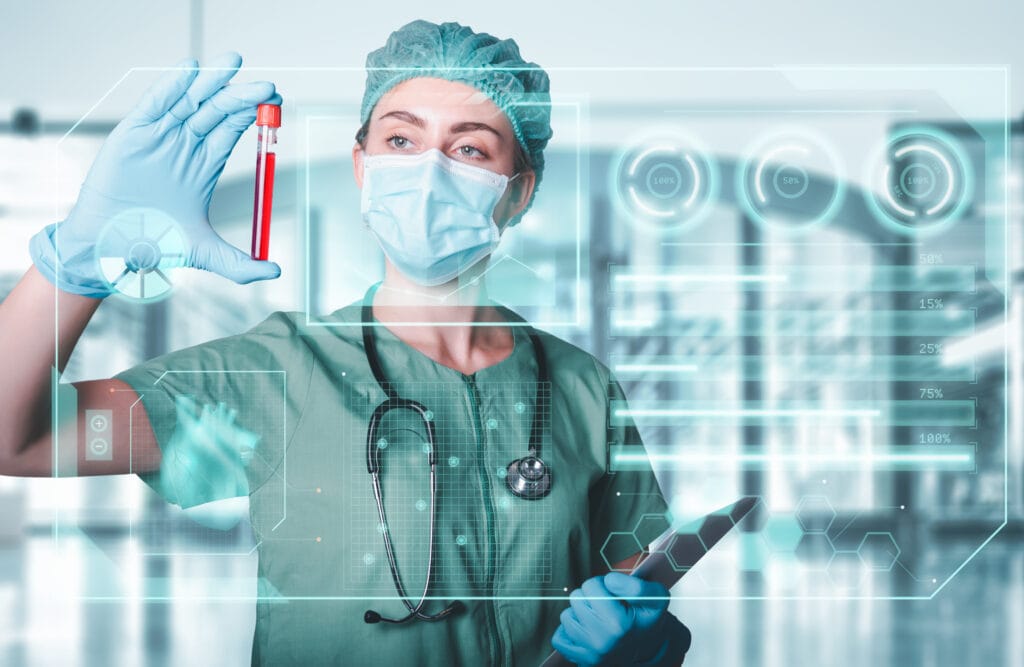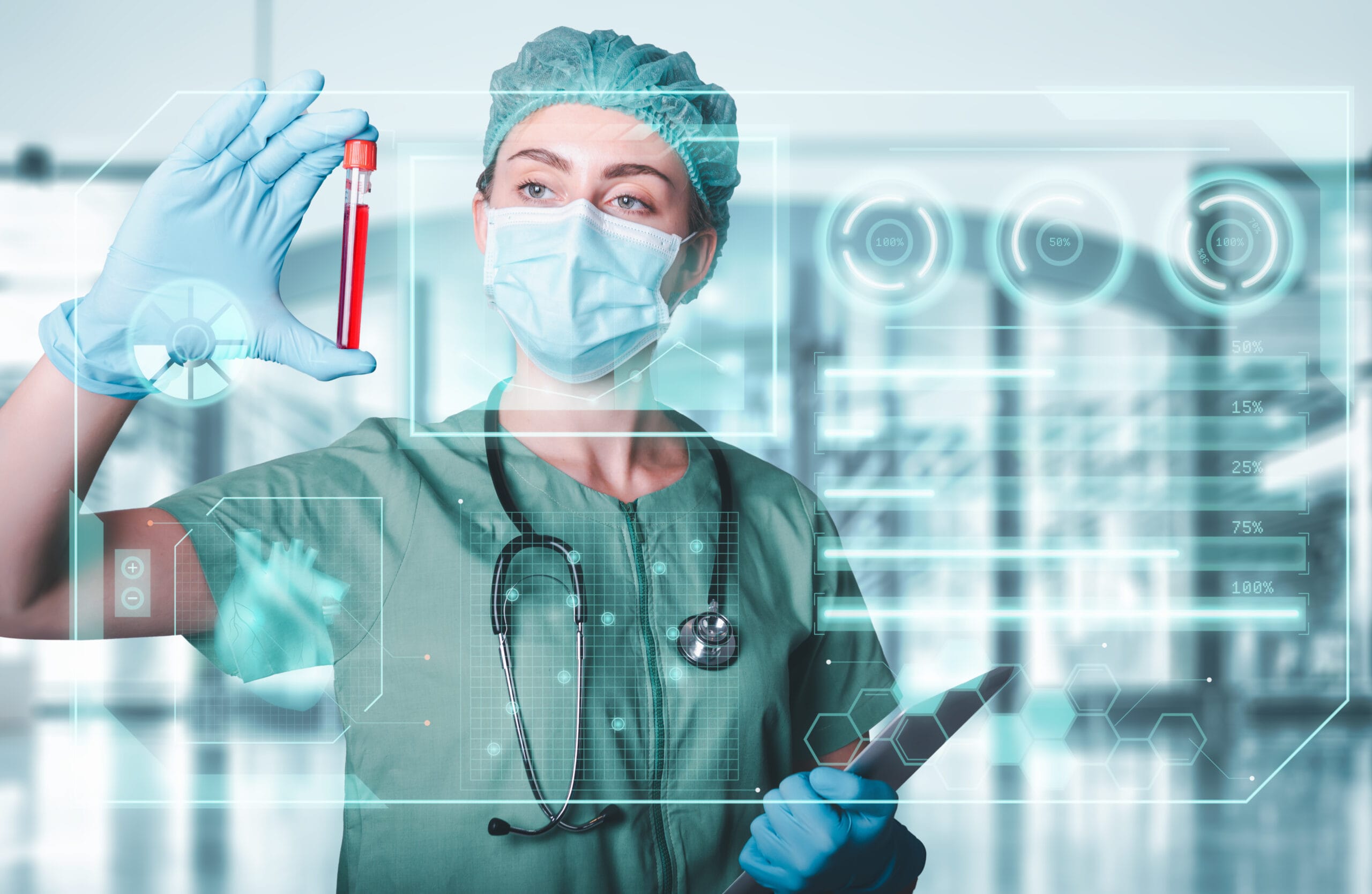The Evolution of Medical Diagnostics with AI
Medical diagnostics has come a long way from relying solely on physical exams and rudimentary tools. With AI integration, medical diagnostics now advance rapidly, delivering high accuracy, speed, and insight. AI revolutionizes diagnostics with rapid analysis of extensive datasets, uncovering hidden patterns in patient histories and imaging scans.
This transformation is not only improving diagnostic precision but also reducing human error, leading to more accurate and personalized care for patients. As a result, AI is reshaping how we understand, approach, and treat illnesses across the healthcare landscape.
How AI is Shaping Modern Medical Diagnostics
AI’s role in diagnostics is expanding rapidly. AI systems use advanced models to process medical data in real-time, unlike traditional diagnostics that rely on healthcare provider experience. These systems “learn” from each diagnosis, continually improving their accuracy over time.
An AI system can recognize disease patterns in MRI and CT scans like cancer, Alzheimer’s, or cardiovascular issues. As AI learns from each case, it becomes more adept, often surpassing human ability in detecting subtle anomalies.
Beyond imaging, AI is revolutionizing diagnostics in areas like genetic data analysis and pathology. Machine learning algorithms can examine genetic markers and suggest potential health risks, which allows for earlier intervention. In pathology, AI algorithms assist in analyzing biopsy samples, speeding up the time it takes to reach a diagnosis. Advancing AI tech makes diagnostics faster, more consistent, & less biased.
Benefits of AI in Medical Diagnostics: Precision and Efficiency
Precision and efficiency are two core benefits AI brings to medical diagnostics. Traditional methods, while effective, are often resource-intensive and require significant time, particularly when specialists are involved. With AI, diagnostics can become significantly more efficient. Single scans are now analyzed quickly, often detecting details missed by humans.
AI can detect cancer by examining tissue samples with precision, spotting early signs of the disease. This precision is essential because early diagnosis directly impacts treatment success rates.
AI boosts efficiency by handling patient datasets, organizing information, and highlighting areas for review. Artificial Intelligence taking on tasks in healthcare frees up time for providers, enhancing the system’s capacity to serve more people efficiently.
AI in Imaging: Transforming X-rays, MRIs, and CT Scans
Medical imaging has greatly benefited from AI, particularly in interpreting X-rays, MRIs, and CT scans. Traditional image analysis is a meticulous process, often requiring multiple specialists to reach a conclusion. AI, however, speeds up this process by using image recognition algorithms trained on millions of images to identify abnormalities in seconds. These algorithms detect subtle differences that might not be immediately apparent to the human eye, enabling earlier diagnoses.

For instance, AI can analyze X-ray images to detect fractures, tumors, or lung conditions with high accuracy. In MRI and CT scans, AI helps in detecting lesions or growths that may signal serious conditions like brain tumors, strokes, or cardiovascular diseases. AI-driven imaging also provides a more consistent analysis across cases, ensuring a standardized approach to diagnosis. Many hospitals now use AI-powered imaging tools as the first line of analysis, with radiologists reviewing the AI’s findings. This collaborative approach ensures that patients receive the most accurate diagnoses while significantly reducing wait times.
Early Disease Detection: AI’s Role in Predictive Diagnostics
Predictive diagnostics is a burgeoning field that uses AI to identify the likelihood of diseases developing before symptoms even appear. With predictive diagnostics, doctors can make more proactive treatment decisions, ultimately improving patient outcomes. AI-driven predictive diagnostics often rely on a combination of genetic data, lifestyle factors, and patient history. By analyzing this data, AI can generate risk scores for conditions such as heart disease, diabetes, and cancer, allowing doctors to recommend lifestyle changes or preventive measures before serious symptoms arise.
This early detection approach is particularly beneficial for hereditary conditions, as AI can flag potential issues based on family history and genetic markers. For example, in cardiology, AI-powered tools assess a patient’s heart health by analyzing imaging scans, blood pressure data, and cholesterol levels, predicting the likelihood of a heart attack or stroke. In oncology, AI can analyze genetic mutations to predict cancer risks, giving patients a chance to explore preventive treatments. Predictive diagnostics, made possible through AI, represents a leap forward in the ability to address health risks before they escalate.
AI-Powered Diagnostic Tools: From Algorithms to Patient Care
The impact of AI extends beyond just algorithms; AI-powered diagnostic tools are now playing a direct role in patient care. These tools are not only improving diagnosis but also providing patients with real-time health insights. For instance, wearable devices equipped with AI monitor vital signs and alert both the patient and their healthcare providers if something unusual occurs. These AI-powered tools collect valuable data from daily life, which can be used to fine-tune treatments and monitor conditions.
In addition, point-of-care AI tools are becoming more common, helping clinicians make quick decisions in real-time. For example, handheld ultrasound devices powered by AI can provide on-the-spot diagnostics in emergency rooms, ensuring that critical conditions are identified and treated as swiftly as possible. As AI-powered diagnostic tools become more prevalent, they are bridging the gap between diagnosis and treatment, ensuring patients receive timely and effective care.
Improving Accuracy in Diagnosis: How AI Reduces Human Error
One of AI’s greatest advantages in diagnostics is its ability to reduce human error. No matter how skilled, healthcare professionals are susceptible to fatigue and cognitive biases. AI, however, operates with consistency, examining data without the influence of subjective factors. By flagging potential errors or inconsistencies, AI helps reduce the margin of error in diagnoses.
For example, in pathology, AI assists in examining biopsy samples with consistent precision, reducing the likelihood of misdiagnosis due to human oversight. Radiology also benefits from AI’s ability to spot irregularities in imaging scans that may not be immediately visible. By acting as a second pair of “eyes,” AI provides an additional layer of accuracy, ensuring that diagnoses are thorough and reliable.
How Machine Learning is Helping Identify Rare Diseases
Rare diseases often present a unique diagnostic challenge due to their unusual symptoms and low prevalence, leading to frequent misdiagnoses. AI and machine learning algorithms are addressing this challenge by analyzing genetic data, medical records, and symptom patterns to recognize conditions that might otherwise go unnoticed. With AI, physicians have a powerful tool to assist in diagnosing rare diseases by comparing patient data to known cases.
One example of this is in genomics, where AI examines genetic sequences to detect markers of rare genetic disorders. Additionally, machine learning models are being developed to identify combinations of symptoms and patterns that align with rare diseases. This capability significantly shortens the diagnostic journey for patients with rare diseases, helping them receive appropriate treatment much sooner.
Real-World Applications of AI in Medical Diagnostics
AI is already making a tangible difference in diagnostics across various fields. In oncology, AI aids in identifying tumors at earlier stages, giving patients a better chance at recovery. In cardiology, AI algorithms predict potential heart conditions, reducing the risk of sudden cardiac events. Additionally, AI in dermatology helps dermatologists screen for skin cancers with improved accuracy. These real-world applications showcase AI’s adaptability and effectiveness across multiple specialties, setting a new standard in medical diagnostics.
Challenges and Ethical Considerations in AI Diagnostics
Despite its advantages, AI in diagnostics faces challenges and ethical concerns. Privacy is a major issue, as patient data must be securely managed to prevent misuse. Moreover, there are ethical questions surrounding the reliance on AI for life-altering decisions. Ensuring that AI is used as a tool, rather than a replacement for human judgment, is essential in maintaining patient trust. Regulatory frameworks are also evolving to oversee AI in diagnostics, ensuring safety and fairness in its applications.
The Future of Medical Diagnostics: What’s Next for AI?
The future of AI in diagnostics is promising, with continued advancements in machine learning and data processing capabilities. As AI becomes more integrated into healthcare, we may see fully automated diagnostic systems capable of providing real-time analysis and insights. With improvements in natural language processing, AI could become even more patient-friendly, answering questions and guiding patients through the diagnostic process. The potential of AI in diagnostics is only beginning to unfold, and as technology evolves, so too will the ways it can improve patient care.
The Promise of AI in Smarter, Faster, and Better Medical Diagnostics
In conclusion, as we’ve seen throughout this journey into AI-driven diagnostics, the impact of Artificial Intelligence on healthcare is profound. Not only does AI bring unparalleled precision to diagnosing complex conditions, but it also speeds up the process, which is crucial for time-sensitive cases. Furthermore, with each technological advancement, the potential of AI grows, offering an ever-expanding range of tools to doctors and patients alike.
Moreover, as AI systems continue to learn from vast amounts of medical data, they become even more accurate and reliable, allowing healthcare providers to make better, more informed decisions. On top of this, AI’s role in early disease detection and predictive diagnostics could soon become a cornerstone of preventive care, enabling us to tackle illnesses before they fully develop.
Even though there are ethical and regulatory hurdles to navigate, AI’s benefits in diagnostics are undeniable. Moving forward, we can expect a future where AI doesn’t just support diagnostics but also transforms how we perceive and approach healthcare itself. Altogether, with AI and human expertise working in tandem, the future of medical diagnostics is indeed smarter, faster, and better for patients worldwide.

